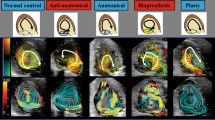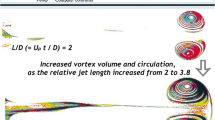Abstract
Left ventricular vortex formation time (VFT) is a novel dimensionless index of flow propagation during left ventricular diastole, which has been demonstrated to be useful in heart failure and cardiomyopathy. In mitral stenosis (MS), flow propagation in the LV may be suboptimal. We studied VFT in varying degrees of MS. Echocardiography was performed on 20 healthy controls and 50 cases of rheumatic MS. Patients with atrial fibrillation, LV ejection fraction < 50% and other valvular heart diseases were excluded. VFT was obtained using the length-to-diameter ratio (L/D), where L is the continuous-wave Doppler velocity time integral stroke distance, divided by D, the mitral leaflet separation index. This was correlated against varying degrees of MS severity, left atrial (LA) volume and function. In controls, VFT was 3.92 ± 2.00 (optimal range) and was higher (suboptimal) with increasing severity of mitral stenosis (4.98 ± 2.43 in mild MS; 7.22 ± 2.98 in moderate MS; 11.55 ± 2.67 in severe MS, p < 0.001). VFT negatively correlated with mitral valve area (R2 = 0.463, p < 0.001) and total LA emptying fraction (R2 = 0.348, p < 0.001), and positively correlated with LA volume index (R2 = 0.440, p < 0.001) and mean transmitral pressure gradient (R2 = 0.336, p < 0.001). More severe MS correlated with suboptimal (higher) VFT. The restricted mitral valve opening may disrupt vortex formation and optimal fluid propagation in the LV. Despite the compensatory increase in LA size with increasingly severe MS, reduced LA function also contributed to the suboptimal LV vortex formation.





Similar content being viewed by others
References
Poh KK, Lee LC, Shen L, Chong E, Tan YL, Chai P, Yeo TC, Wood MJ (2012) Left ventricular fluid dynamics in heart failure: echocardiographic measurement and utilities of vortex formation time. Eur Heart J Cardiovasc Imaging 13(5):385–393
Pelà G, Bruschi G, Montagna L, Manara M, Manca C (2004) Left and right ventricular adaptation assessed by Doppler tissue echocardiography in athletes. J Am Soc Echocardiogr 17(3):205–211
Vinereanu D, Florescu N, Sculthorpe N, Tweddel AC, Stephens MR, Fraser AG (2001) Differentiation between pathologic and physiologic left ventricular hypertrophy by tissue Doppler assessment of long-axis function in patients with hypertrophic cardiomyopathy or systemic hypertension and in athletes. Am J Cardiol 88(1):53–58
Rawlins J, Bhan A, Sharma S (2009) Left ventricular hypertrophy in athletes. Eur J Echocardiogr 10(3):350–356
Carlhäll CJ, Bolger A (2010) Passing strange: flow in the failing ventricle. Circ Heart Fail 3(2):326–31
Belohlavek M (2012) Vortex formation time: an emerging echocardiographic index of left ventricular filling efficiency. Eur Heart J Cardiovasc Imaging 13(5):367–369
Dabiri JO, Gharib M (2005) The role of optimal vortex formation in biological fluid transport. Proc Biol Sci 272:1557–1560
Gharib M, Rambod E, Shariff K (1998) A universal time-scale of vortex formation time. J Fluid Mech 360:121–140
Gharib M, Kremers D, Koochesfahani MM, Kemp M (2002) Leonardo’s vision of flow visualization. Exp Fluids 33:219–223
Gharib M, Rambod E, Kheradvar A, Sahn DJ, Dabiri JO (2006) Optimal vortex formation as an index of cardiac health. Proc Natl Acad Sci USA 103:6305–6308
Raj BSVF, George P, Jose VJ (2008) Mitral leaflet separation index-A simple novel index to assess the severity of mitral stenosis. Indian Heart J 60(6):563–566
Seow SC, Koh LP, Yeo TC (2006) Hemodynamic significance of mitral stenosis: use of a simple, novel index by 2-dimensional echocardiography. J Am Soc Echocardiogr 19(1):102–106
Pagel PS, Boettcher BT, De Vry DJ, Freed JK, Iqbal Z (2016) Moderate aortic valvular insufficiency invalidates vortex formation time as an index of left ventricular filling efficiency in patients with severe degenerative calcific aortic stenosis undergoing aortic valve replacement. J Cardiothorac Vasc Anaesth 30(5):1260–1265
Kheradvar A, Milano M, Gharib M (2007) Correlation between vortex ring formation and mitral annulus dynamics during ventricular rapid filling. ASAJO J 53:8–16
Baumgartner H, Hung J, Bermejo J, Chambers JB, Evangelista A, Griffin BP, Iung B, Otto CM, Pellikka PA, Quinones M (2009) Echocardiographic assessment of valve stenosis: EAE/ASE recommendations for clinical practice. Eur J Echocardiogr 10:1–25
Thomas JK, Anoop TM, Sebastian GB, George K, George R (2011) Mitral leaflet separation index in asessing severity of mitral stenosis. ISRN Cardiol. https://doi.org/10.5402/2011/768097
Madueme P, Hor KN, Germann J, Mazur W, Jefferies JL, Taylor M (2012) Comparison of area-length method by echocardiography versus full volume quantification by cardiac magnetic resonance imaging for the assessment of left atrial volume. J Cardiovasc Magn Reson 14(Supp 1):P297
Pasipoularides A, Vlachos PP, Little WC (2015) Vortex formation time is not an index of ventricular function. J Cardiovasc Transl Res 8(1):54–58
King G, Ngiam N, Clarke J, Poh KK (2019) Left ventricular vortex formation time in elite athletes. Int J Cardiovasc Imaging 35(2):307–311
Lee LC, Tan YL, Tan HC, Omar AR, Chai P, Yeo TC et al (2007) Abstract 3289: vortex formation index in heart failure: novel non-invasive assessment of fluid dynamics using transthoracic echocardiography. Circulation 116:II741
Krueger P, Gharib M (2003) The significance of vortex ring formation to the impulse and thrust of a starting jet. Phys Fluids 15:1271–1281
Mohseni K, Gharib M (1998) A model for universal time scale of vortex ring formation. Phys Fluids 10:2436–2438
Hong GR, Pedrizzetti G, Tonti G, Li P, Wei Z, Kim JK et al (2008) Characterization and quantification of vortex flow in the human left ventricle by contrast echocardiography using vector particle image velocimetry. JACC Cardiovasc Imaging 1:705–717
Funding
None reported.
Author information
Authors and Affiliations
Corresponding author
Ethics declarations
Conflict of interest
The authors declare that they have no conflict of interest.
Additional information
Publisher's Note
Springer Nature remains neutral with regard to jurisdictional claims in published maps and institutional affiliations.
Rights and permissions
About this article
Cite this article
Ambhore, A., Ngiam, J.N., Chew, N.W.S. et al. Optimal vortex formation time index in mitral valve stenosis. Int J Cardiovasc Imaging 37, 1595–1600 (2021). https://doi.org/10.1007/s10554-020-02140-9
Received:
Accepted:
Published:
Issue Date:
DOI: https://doi.org/10.1007/s10554-020-02140-9




